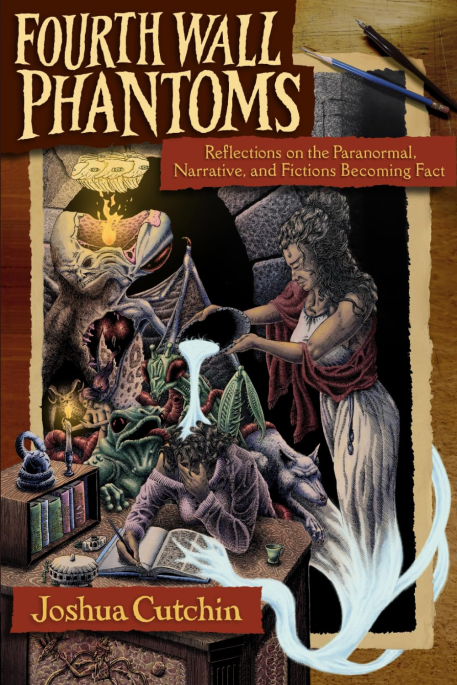
Reviewed by Nemo C. Mörck
Fourth Wall Phantoms is the latest in a series of books by Joshua Cutchin. His previous books concern the paranormal, ufology, and cryptozoology. I know more about parapsychology than I know about UFOs or cryptids, so Cutchin has to act as my guide. I appreciate the chance to tag along and follow his train of thought. He seems utterly unconcerned by warning signs, such as ”dead end up ahead” and ”paradoxes imminent”, and moves on in a brisk pace. It turns out to be a long journey - about 434 pages text plus references, index, and 1515 endnotes! I follow, equipped with my own beliefs and biases. I believe that the paranormal has always been associated with entertainment and fraud.
Cutchin describes his book as a ”thought experiment” (p. 18) and generously shares both his own and others’ thoughts. Appropriately enough he occasionally breaks the fourth wall and address the reader directly. The book is written in an informal style, but some sections are complex. His humour is wasted on me, but others may smile. One example: ”Proceed with a charitable disposition or roll your eyes as warranted” (p. 151).
He covers a lot of ground, but ”fictional incursions” is one of the main themes. So what exactly does that mean? Hallucinations seen by one person? Apparitions seen by multiple persons? Materialized entities that, at least temporarily, are as real as you and me? All kinds appear in the book, though from the case reports it is not always clear whether more than one person saw the entity or not. The entities range from imaginary playmates to cryptids and aliens. I quote just one case report here:
In other instances, the Grim Reaper appears in full regalia, brandishing his hallmark scythe. In fact, it was this implement that saved witness Dennis Wardrop when he fell through the ice at eight years old. After plunging into a pond, Dennis grabbed hold of something sturdy and wooden. Once it had pulled the boy to the surface, the cloaked figure revealed its decomposing face and red eyes, then telepathically instructed Dennis it was not yet his time to die (emphasis in original, p. 47)
The interpretation of most interest to Cutchin is that some of the entities may be tulpas. He notes that Mikles and Laycock (2015) have traced the concept back to Alexandra David-Néel and Theosophy. I gather that what we today mean by the concept owes more to Theosophy than Tibetan Buddhism. In short, tulpas are mental creations that take form and seem to take on a life of their own. Writers such as Keel (1975b), Rogo (1977), and Steiger (1978) picked up the concept. More recently it found fertile ground and much can now easily be found online about Tulpamancy, the practice of creating tulpas. They even caught the interest of Parker (2021), though he admitted that they do not provide ”the ultimate sought-after deeper explanation” (p. 97).
My impression is that part of the challenge for ufologists and cryptozoologists is that the UFOs and cryptids are not only elusive – they also seem paradoxical, sometimes they can leave traces and can be heard yet suddenly disappear as if they were just hallucinations. Personally, I don’t expect to live to see Bigfoot in a zoo (or to see a Disclosure that ufologists find satisfactory), but surely most of the experiencers and abductees have experienced something unusual? They seem acutely aware of how bizarre some of the experiences sound and sometimes struggle to explain. In addition, although imaginary playmates most often seem to be harmless fantasies sometimes they do and seem to know things that make one wonder about their true nature (e.g., Hallowell, 2006)
Possible tulpas appear throughout the book, and Cutchin even argues that Ramesh’s (2023) work about fictional incursions is ”essential to fully understanding” (p. 33) Fourth Wall Phantoms. Jeffrey Kripal’s and Eric Wargo’s books are also often cited and sections are devoted to their views.
Cutchin covers much more, in addition to tulpas: ”Primarily, I focus on archetypes, ideas, creativity, narrative, and what they can teach us about the paranormal” (p. 19). He has read Jung and remarks ”when I look at Carl Jung, I see nothing less than a genuine mystic” (emphasis in original, p. 368). If one reads Jung as a mystic rather than as a scientist one does not expect precise definitions of concepts such as archetypes or the collective unconscious - and it may well be easier to appreciate his perspective then. As readers familiar with Hansen (2001) know the Trickster archetype in particular has been associated with the paranormal and not without reason.
Cutchin writes about ideas almost as if they were living things hunting after victims. Concerning narratives folklorists may appreciate the coverage given to Vladimir Propp’s ideas. I must admit that I did not find this as interesting as other sections, but I am not at all convinced that "there often is a plot behind paranormal encounters" (emphasis in original, p. 123). Many experiences seem brief and sudden, leaving bemused experiencers and researchers with little to analyse. That said, sometimes the events are dramatic and change the experiencers forever.
At one point Cutchin suggests: ”UFOs are nothing more than plot devices, meant to push us forward through our stories, our lives” (p. 82). To me it seems more likely that people just happen to be at the wrong place at the wrong time, though some have a number of experiences. Our different perspectives may be due to our different beliefs and worldviews. Cutchin is a Christian. I could introduce myself as an agnostic to be polite.
Sometimes the going gets tough for those less familiar with the relevant literature, but Cutchin is a pleasant guide and draws attention to more and more intriguing cases and curiosities. He remarks: ”I believe most experiencers. To a fault. After all, I wasn’t there” (p. 232). He notes that John Keel (1975a) found that: “Somehow the phenomenon reflects back material that supports whatever beliefs or theories motivate the investigators …” (p. 120) after Keel had seen evidence of this in his own life. Perhaps it is best to not believe in demons.
It may be hard to maintain what Cutchin calls the pH of Disbelief ”that sweet spot between wild-eyed zealotry and obstinate skepticism” (p. 240) throughout the journey, but he describes this as a thought experiment so one should at least entertain the possibility that he is basically right about everything and see where that leads. Cutchin does not lead us to a happily ever after in which everything makes sense, but he has certainly done his homework, (though perhaps he has relied a bit too heavily on the secondary literature when it comes to parapsychology), and has really pondered on the various possibilities and their implications.
I do have some quibbles. For example, he believes that “poltergeists suggest that we are capable of generating things once considered spirits” (emphasis in original, p. 310). However, it is just an interpretation – we only know that the phenomena seem to follow certain persons. Roll (1972) acknowledged: “We are still making an assumption, namely that poltergeist effects are produced by the mind or psyche of somebody, whether or not this somebody is in the flesh” (p. 10). In addition, “A cursory survey of the near-death experience literature finds that little distinguishes the content of these experiences from dreams” (p. 344) strikes me as an unfortunate statement, especially since Cutchin knows so much about both.
Towards the end Cutchin notes: ”My work is all about entertaining completely different ideas from book to book, moving forward into new areas” (p. 432) and I, for one, am curious about what he has in mind for future books. I cannot really do this book justice in a brief review, but I am happy to recommend Fourth Wall Phantoms – if you enjoy reading Fortean Times then you are likely to enjoy reading this.
References
Hallowell, M. (2006). Invizikids: Imaginary childhood friends. Magonia 93, 10-12.
Hansen, G. P. (2001). The trickster and the paranormal. Xlibris.
Keel, J. A. (1975a). The eighth tower. Saturday Review Press.
Keel, J. A. (1975b). The mothman prophecies. Saturday Review Press.
Mikles, N. L., & Laycock, J. P. (2015). Tracking the tulpa: exploring the “Tibetan” origins of a contemporary paranormal idea. Nova Religio, 19(1), 87-97
Parker, A. (2021). Thought-forms gone rogue: a theory for psi-critics and parapsychologists. Journal of Scientific Exploration, 35(1), 91-128.
Ramesh, C. (2023). Embodied imaginations: Fictional characters making experiential crossings into real life: an unusual phenomenon. Motilal Banarsidass Publishing House.
Rogo, D. S. (1977). The haunted universe. Signet.
Roll, W. G. (1972). The poltergeist. Nelson Doubleday.
Steiger, B. (1978). Alien meetings. Ace Books.

